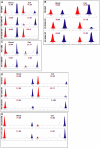Isogenic pairs of wild type and mutant induced pluripotent stem cell (iPSC) lines from Rett syndrome patients as in vitro disease model
- PMID: 21966470
- PMCID: PMC3180386
- DOI: 10.1371/journal.pone.0025255
Isogenic pairs of wild type and mutant induced pluripotent stem cell (iPSC) lines from Rett syndrome patients as in vitro disease model
Abstract
Rett syndrome (RTT) is an autism spectrum developmental disorder caused by mutations in the X-linked methyl-CpG binding protein 2 (MECP2) gene. Excellent RTT mouse models have been created to study the disease mechanisms, leading to many important findings with potential therapeutic implications. These include the identification of many MeCP2 target genes, better understanding of the neurobiological consequences of the loss- or mis-function of MeCP2, and drug testing in RTT mice and clinical trials in human RTT patients. However, because of potential differences in the underlying biology between humans and common research animals, there is a need to establish cell culture-based human models for studying disease mechanisms to validate and expand the knowledge acquired in animal models. Taking advantage of the nonrandom pattern of X chromosome inactivation in female induced pluripotent stem cells (iPSC), we have generated isogenic pairs of wild type and mutant iPSC lines from several female RTT patients with common and rare RTT mutations. R294X (arginine 294 to stop codon) is a common mutation carried by 5-6% of RTT patients. iPSCs carrying the R294X mutation has not been studied. We differentiated three R294X iPSC lines and their isogenic wild type control iPSC into neurons with high efficiency and consistency, and observed characteristic RTT pathology in R294X neurons. These isogenic iPSC lines provide unique resources to the RTT research community for studying disease pathology, screening for novel drugs, and testing toxicology.
Conflict of interest statement
Figures





References
-
- Hagberg B. Rett's syndrome: prevalence and impact on progressive severe mental retardation in girls. Acta Paediatr Scand. 1985;74:405–408. - PubMed
-
- Hagberg B, Hagberg G. Rett syndrome: epidemiology and geographical variability. Eur Child Adolesc Psychiatry. 1997;6(Suppl 1):5–7. - PubMed
-
- Chahrour M, Zoghbi HY. The story of Rett syndrome: from clinic to neurobiology. Neuron. 2007;56:422–437. - PubMed
-
- Amir RE, van den Veyver IB, Wan M, Tran CQ, Francke U, et al. Rett syndrome is caused by mutations in X-linked MECP2, encoding methyl-CpG-binding protein 2. Nat Genet. 1999;23:185–188. - PubMed
-
- van den Veyver IB, Zoghbi HY. Methyl-CpG-binding protein 2 mutations in Rett syndrome. Curr Opin Genet Dev. 2000;10:275–279. - PubMed
Publication types
MeSH terms
Substances
Grants and funding
LinkOut - more resources
Full Text Sources
Other Literature Sources
Medical
Research Materials

